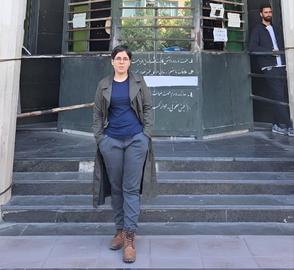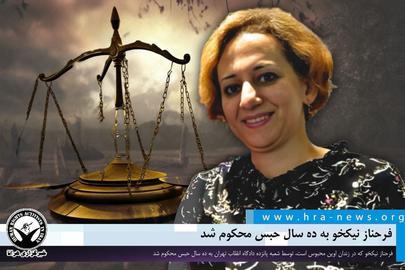The earliest known photograph of Taj ol-Saltaneh depicts a nine-year-old girl, looking straight ahead and away from the camera, her hair stuck through with flowers and hairpins. She was the most rebellious daughter of the absolute 19th century Qajar King Naser al-Din Shah, the first princess who came out from behind the purdah of the royal harem, removed her hijab, fearlessly talked about women’s rights and harshly criticized the oppressive laws that ruled women’s lives under the governments of his father, his brother and his nephew. These criticisms are recorded in her memoirs, written in 1914 but published only in 1996, which undoubtedly are one the most important sources for social and political history of contemporary Iran.
Zahra Khanom Taj ol-Saltaneh was the 15th daughter of Naser al-Din Shah and his 29th child. According to her diaries, she was born in 1883 in Tehran’s Golestan Palace. Her mother, Turan ol-Saltaneh, was an official wife of the king and the daughter of Naser al-Din Shah’s uncle, Khosro Mirza. She writes that her mother was a religious and submissive woman who placed her daughter in the care of a black maid who spoiled her to no end and gave her whatever she wanted.
Love for an “Incompetent” and “Childish” Father
Despite what the future held in store for her, Taj ol-Saltaneh was very fond of her father, who returned the affection. He provided her with a teacher of literature and sciences and bestowed upon her the honorific title Taj ol-Saltaneh (“Crown of the Kingdom”), which effectively became her name.
The fondness she felt toward her father did not stop her from criticizing him. She believed that his incompetence, his indulgence in worldly pleasures and his childishness were the main causes of Iran’s problems. Examples of the king’s behavior that she cited as strange and childish were his strong attachment to Babri Khan, his cat, and “Malijak” Aziz ol-Soltan (“King’s Favorite”), a pageboy in the court.
Naser al-Din Shah wanted to marry off Taj ol-Saltaneh to Malijak, but this choice enraged her mother Turan ol-Saltaneh who, according to Taj, shouted: “I will poison my daughter and kill her. I will never accept this man as her groom.” In turn, Shah became so angry that he expelled her mother from his harem and put Taj in the care of Anis al-Doleh, his favorite wife who managed to save Taj ol-Saltaneh from marriage to Malijak.
A Privileged But Unhappy Princess
Eventually, when she reached puberty, Taj ol-Saltaneh married Hassan Shoja ol-Saltaneh, an aristocrat and son of the defense minister, in a magnificent ceremony. The marriage started with love but ended in a bitter divorce due to her husband's infidelity. She was one of the first ever royal women to get a divorce.
Marriage had interrupted Taj ol-Saltaneh’s education, something that she missed dearly. In her memoirs she wrote that, although she had a privileged life as a princess, her life was not a happy one. She was particularly frustrated because, as a woman and as a princess, she could not see the world beyond the confines of her home and could not learn what she wanted to.
The assassination of Naser al-Din Shah in 1896 was a very sad event for Taj ol-Saltaneh, but it released her from the bonds of marriage.
At the coronation ceremony of her brother Mozaffar ad-Din Shah, she refused to wear a colorful dress he had sent her, instead wearing a black dress because a year had not yet passed since Naser al-Din Shah’s death.
As time passed, her opposition to the reign of her brother increased and she eventually became one of his open critics. Taj ol-Saltaneh saw her brother as incompetent, ignorant, lacking self-esteem and a hedonist who had destroyed the country with unnecessary and expensive travels abroad and with irresponsible lending and ministerial appointments.
"Under the reign of my dear brother,” she writes, “premiership and ministership were highly similar to a Ta'zieh [Shia passion play], with the performer constantly leaving and returning onstage in a new costume. This dear brother of mine dismisses a prime minister on the recommendation of a two-year-old child and removes a minister on the recommendation of a clown."
Discovering Feminism and Politics
Following her divorce, Taj ol-Saltaneh went to Europe to continue her education. She learned French, got to know women rights activists and became familiar with feminist thinking. This experience prepared her to become a trailblazing advocate for women’s rights in Iran.
Upon her return to Iran, she expanded her education into new fields. She learned how to play the traditional Iranian string instrument tar with Mirza Abdollah Farahani, a master musician, and to paint with her cousin Soleiman Sepahbodi. During this period she started writing about her life and ideals.
Taj ol-Saltaneh was also one of the first Iranian women who went beyond demands for gender equality and engaged in politics, especially after the Iranian Constitutional Revolution started in 1905, while his brother Mozaffar ad-Din Shah was still king.
Around 1910, Taj became a founding member of the Anjoman-e Horriyyat-e Nsevan (Society of Women's Freedom), a semi-underground organization striving for equal rights for women. It was set up as a response to the male-dominated Anjoman-e Okhovat (Brotherhood Society), a Freemason-style mystical society set up in 1899. Taj secretly organized and attended meetings of the women’s group, telling her children and grandchildren that she was attending religious sessions. She even organized a women’s march to parliament in support of women’s cause.
Ignorance, Women’s Main Enemy
In her memoirs, Taj insists that the most significant detriment to women in Iran was their own ignorance of their rights. "Alas,” she wrote, “Iranian women are separated from the human species and are among the beasts and wild animals. From morning until night, they live despairingly in an enclosed space and spend their lives suffering from immense pressure and misery.”
“They read in newspapers how the egalitarian women of Europe defend their rights, and of how seriously they demand them. I want to travel to Europe and meet these women, and tell them, ‘While you are blissfully and nobly defending your rights and victoriously attaining your goals, cast a glance at Asia; take a look at the houses with their high walls, with just one opening, which is the entrance door, guarded by a doorkeeper...[where women live] under the chain of captivity and unquestionable power, some with broken heads and hands, some pale, some hungry and naked, some waiting, moaning all the while.”
“I’d tell them again: ‘These are all women. These are all human beings. They are all respectable and worthy of appreciation. See what a life they are living.’"
Taj ol-Saltaneh was the first Iranian princess who removed her hijab, and there are many pictures of her dressed in Western clothing. She was a fearless woman who expressed both her ideals and her love outspokenly, in words and in prose. It is said that after she met the famous Persian poet Aref Qazvini at a party they fell in love, and though they never married, their affair was immortalized in a song he wrote for her, “Ey Taj.”
Taj ol-Saltaneh died in 1936 at the age of 54. She was buried at Zahir ol-Doleh Cemetery in northern Tehran in accordance with her will, close to the graves of two of her sisters. It would be another 60 years until her memoirs were published and she was recognized as one of the most important feminist pioneers of the early 20th century.
Her memoirs were translated into English and were published in 2003 under the title Crowning Anguish.
visit the accountability section
In this section of Iran Wire, you can contact the officials and launch your campaign for various problems


























comments